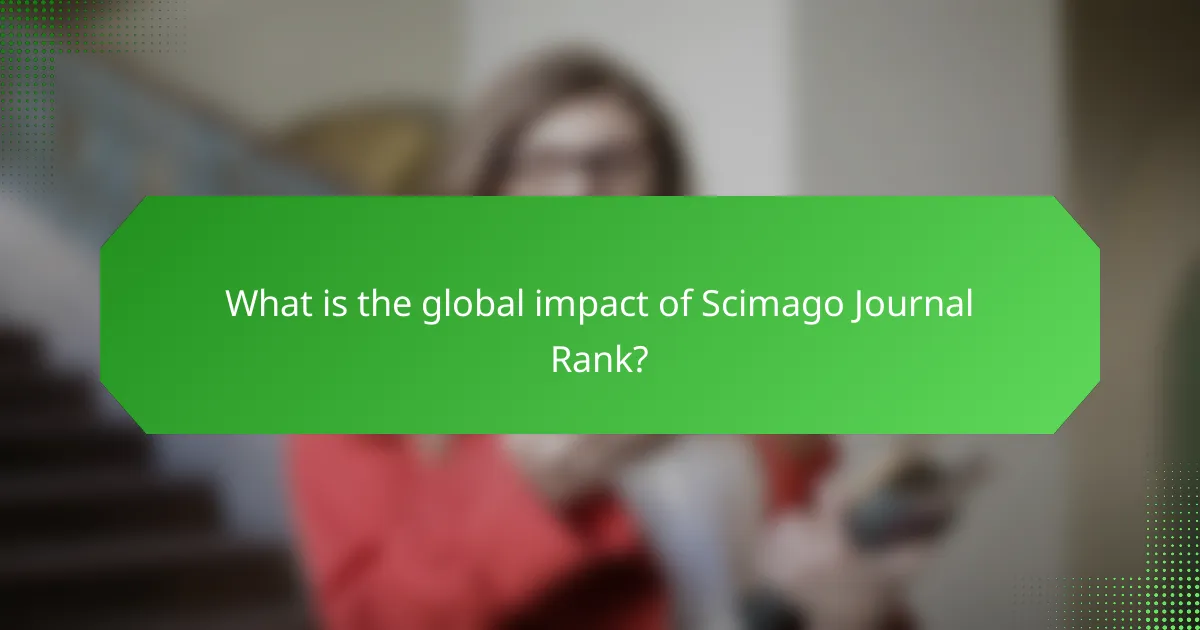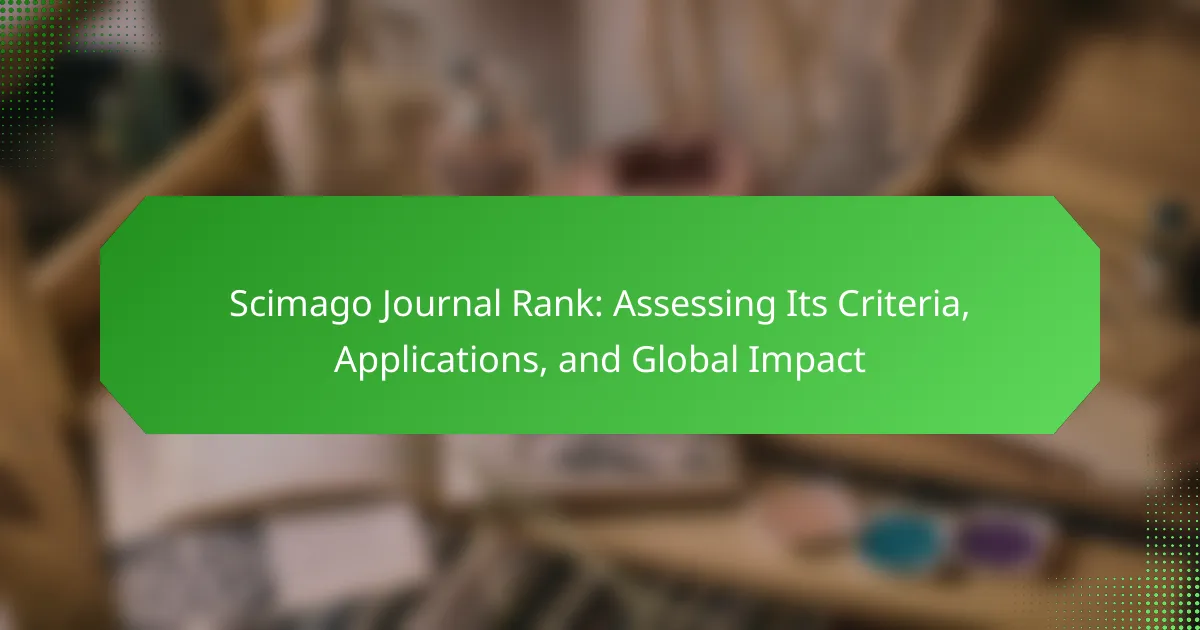Scimago Journal Rank (SJR) is a metric that evaluates the impact and quality of academic journals based on citation data from the Scopus database. It measures the average number of citations received by articles published in a journal over a three-year period, considering both the quantity and quality of those citations. The ranking system is updated annually, reflecting changes in citation patterns and helping researchers identify influential journals in their fields. SJR not only assists researchers in choosing publication venues but also aids institutions in assessing faculty performance and influences funding decisions and library acquisitions globally.

What is Scimago Journal Rank?
Scimago Journal Rank (SJR) is a metric that evaluates the impact of academic journals. It measures the average number of citations received by articles published in a journal over a three-year period. SJR is based on the Scopus database, which includes a wide range of scientific publications. The metric accounts for both the quantity and quality of citations. Journals with higher SJR scores are considered more prestigious. The ranking is updated annually to reflect changes in citation patterns. This metric helps researchers identify influential journals in their fields.
How is Scimago Journal Rank calculated?
Scimago Journal Rank is calculated using a formula that considers both the number of citations received by a journal’s articles and the number of articles published. The calculation is based on data from Scopus, which provides citation data. The formula incorporates the total number of citations to the journal in a given year, divided by the total number of articles published in the previous three years. This method emphasizes the impact of recent publications while accounting for the journal’s output. The resulting score reflects the journal’s influence within its field.
What are the key metrics used in the calculation?
The key metrics used in the calculation of the Scimago Journal Rank (SJR) include the number of citations received by a journal’s articles. This metric is adjusted for the prestige of the journals where such citations come from. The SJR also considers the number of documents published by the journal in a given period. These metrics are combined to produce a score that reflects the journal’s overall impact. The SJR metric is widely recognized and utilized in academic publishing for evaluating journal quality.
How do citation counts influence the rank?
Citation counts significantly influence the rank of academic journals. Higher citation counts indicate greater visibility and impact within the scholarly community. This visibility contributes to a journal’s reputation and perceived quality. The Scimago Journal Rank (SJR) specifically incorporates citation counts in its ranking formula. SJR uses a weighted count of citations, factoring in the prestige of the citing journals. Journals that are frequently cited by high-impact journals receive a higher rank. Research shows that citation counts correlate with the journal’s impact factor, reinforcing their importance in rankings. Thus, citation counts are a critical metric in determining a journal’s rank within the Scimago Journal Rank system.
Why is Scimago Journal Rank important for researchers?
Scimago Journal Rank is important for researchers because it provides a comprehensive measure of journal quality. It uses citation data from Scopus to evaluate journals’ impact and visibility. Researchers rely on this metric to identify reputable journals for publication. A high Scimago Journal Rank indicates a journal’s influence in its field. This helps researchers target their submissions effectively. Additionally, it aids in assessing the journal’s reach and audience. The ranking system also supports informed decisions when selecting journals for literature reviews. Overall, it serves as a valuable tool for academic credibility and visibility.
What role does it play in academic publishing?
The Scimago Journal Rank (SJR) plays a significant role in academic publishing by providing a measure of journal quality. It evaluates journals based on citation data from the Scopus database. The SJR metric considers both the number of citations received and the prestige of the citing journals. This approach helps researchers identify reputable journals for publication. It also aids institutions in assessing the impact of their research outputs. The SJR influences funding decisions and academic evaluations. Many researchers and institutions rely on SJR rankings to guide their publishing strategies. The SJR has become a widely recognized tool in the global academic community.
How can it impact a researcher’s career?
The Scimago Journal Rank (SJR) can significantly impact a researcher’s career. A higher SJR score for a researcher’s published work often leads to increased visibility and credibility. This visibility can result in more citations from other researchers. Increased citations can enhance a researcher’s reputation in their field. A strong reputation may lead to better job opportunities and collaborations. Additionally, funding agencies often consider SJR scores when evaluating grant applications. Therefore, publishing in high-SJR journals can be crucial for career advancement. Research shows that articles in higher-ranked journals receive more attention and engagement. This trend underscores the importance of SJR in a researcher’s professional trajectory.
What are the main applications of Scimago Journal Rank?
The main applications of Scimago Journal Rank (SJR) include evaluating the impact of academic journals, guiding researchers in selecting publication venues, and assisting institutions in benchmarking research performance. SJR quantifies journal quality based on citation data, allowing for comparative analysis across disciplines. Researchers use SJR to identify reputable journals for their work. Institutions leverage SJR to assess the research output and influence of their faculty. Additionally, funding agencies may consider SJR metrics when making decisions about grant allocations. SJR provides a comprehensive view of journal performance, which is essential for informed decision-making in academia.
How do institutions utilize the Scimago Journal Rank?
Institutions utilize the Scimago Journal Rank (SJR) to evaluate and compare academic journals. They assess journal quality based on citation data. SJR provides a metric that accounts for both the number of citations and the prestige of the citing journals. This helps institutions make informed decisions about where to publish research. Additionally, SJR aids in identifying leading journals in specific fields. Institutions may also use SJR to benchmark their research output against peers. The ranking influences funding decisions and academic promotions. By analyzing SJR data, institutions can enhance their academic reputation and research strategy.
In what ways can it guide funding decisions?
The Scimago Journal Rank can guide funding decisions by providing a quantitative measure of journal quality. It evaluates journals based on citation metrics and research impact. Funding organizations can use this ranking to assess the credibility of journals for publication. Higher-ranked journals typically indicate more rigorous peer review processes. This can lead to more reliable research outcomes. Additionally, Scimago offers insights into the subject areas where funding is most impactful. By analyzing trends in journal rankings, funders can make informed decisions about resource allocation. This approach enhances the overall effectiveness of research funding.

What are the criteria for Scimago Journal Rank?
The criteria for Scimago Journal Rank include the number of citations received by a journal’s articles. It also considers the number of articles published by the journal. The ranking is based on a three-year period of citation data. Additionally, it factors in the prestige of the journals where the citations come from. The Scimago Journal Rank uses the Scopus database for its calculations. These criteria help in evaluating the impact and quality of academic journals.
What types of journals are included in the Scimago Journal Rank?
The Scimago Journal Rank includes various types of academic journals. These journals are categorized based on their subject areas and impact metrics. The types include journals in the fields of health sciences, social sciences, natural sciences, and engineering. Each journal is evaluated using citation data from Scopus. The ranking system assesses the quality and impact of journals within their respective categories. This categorization allows researchers to identify reputable journals in their fields. The Scimago Journal Rank aims to provide a comprehensive overview of journal performance globally.
How does Scimago categorize journals by discipline?
Scimago categorizes journals by discipline using a classification system based on the Scopus database. This system organizes journals into subject areas and categories. Each journal is assigned to one or more disciplines based on its content and focus. The classification considers factors such as the journal’s title, keywords, and the topics covered in published articles. Scimago utilizes the Journal Subject Area classification from Scopus to ensure consistency and accuracy. This method allows for a comprehensive overview of journal performance within specific fields.
What distinguishes high-ranking journals from others?
High-ranking journals are distinguished by their rigorous peer-review processes, high impact factors, and broad readership. These journals often publish groundbreaking research that significantly influences their fields. They typically attract submissions from leading researchers and institutions. High-ranking journals also maintain stringent editorial standards and often have a low acceptance rate. Their visibility and reputation are enhanced by indexing in major databases like Scopus and Web of Science. Additionally, they often have a strong citation record, indicating that their published articles are frequently referenced by other researchers. This combination of quality, influence, and visibility sets high-ranking journals apart from others.
How does Scimago ensure the accuracy of its rankings?
Scimago ensures the accuracy of its rankings through a rigorous methodology that includes the analysis of citation data. It utilizes data from Scopus, which is a comprehensive abstract and citation database. Scimago applies specific algorithms to evaluate the impact and quality of journals. These algorithms consider various metrics, such as the number of citations received by a journal’s articles. Additionally, Scimago adjusts for differences in citation practices across disciplines. This helps maintain fairness in the ranking process. Regular updates to the database ensure that the rankings reflect the most current data available. Overall, Scimago’s commitment to transparency and data integrity underpins the reliability of its rankings.
What methodologies are employed to verify data?
Data verification methodologies include statistical analysis, cross-referencing, and peer review. Statistical analysis assesses the accuracy and reliability of data through mathematical techniques. Cross-referencing involves comparing data from multiple sources to ensure consistency. Peer review is a process where experts evaluate data and methodologies for validity. These methodologies enhance the credibility of data used in the Scimago Journal Rank. For instance, the Scimago Journal Rank relies on citation data from Scopus, which undergoes rigorous verification processes.
How often are the rankings updated?
The rankings are updated annually. Each year, SCImago Journal Rank releases new rankings based on data from the previous year. This ensures that the rankings reflect the most recent citation data and journal performance metrics. The annual update allows for the incorporation of changes in publication trends and citation practices.

What is the global impact of Scimago Journal Rank?
The global impact of Scimago Journal Rank is significant in academic publishing. It provides a comprehensive metric for evaluating journal quality. Scimago Journal Rank uses citation data from Scopus. It ranks journals based on their visibility and influence in the scholarly community. This ranking system helps researchers choose where to publish their work. Institutions use it to assess the performance of their faculty and research output. It also influences funding decisions and library acquisitions. The Scimago Journal Rank has become a widely recognized tool internationally.
How does Scimago Journal Rank influence international research collaboration?
Scimago Journal Rank influences international research collaboration by providing a standardized metric for journal quality. Researchers often seek to publish in high-ranking journals to enhance visibility and credibility. This metric facilitates the identification of reputable journals across different countries. Consequently, it encourages collaboration among researchers from various institutions aiming for publication in these journals. The Scimago Journal Rank also reflects the impact of research outputs, promoting partnerships that yield high-quality studies. A study by Moed (2010) highlights that such metrics drive researchers to engage in international collaborations for better research dissemination. Thus, the Scimago Journal Rank serves as a catalyst for fostering global research networks.
What trends can be observed in global research outputs?
Global research outputs are increasing steadily, reflecting a rise in scientific productivity. According to the Scimago Journal Rank, the number of published research papers has grown by over 30% in the past decade. This growth is particularly notable in emerging economies, where research output has surged. Collaboration among researchers across countries is also on the rise, leading to a higher number of co-authored papers. Interdisciplinary research is becoming more common, with studies crossing traditional boundaries. Additionally, open access publishing is gaining traction, allowing wider dissemination of research findings. Data from the World Intellectual Property Organization indicates that patent applications linked to academic research are also increasing, showcasing the practical applications of research outputs. Overall, these trends illustrate a dynamic and evolving global research landscape.
How does it affect the visibility of journals worldwide?
The Scimago Journal Rank affects the visibility of journals worldwide by providing a standardized metric for assessing journal quality. This metric allows researchers and institutions to evaluate journals based on citation data. Higher Scimago rankings can lead to increased submissions from authors seeking recognition. Consequently, journals with better visibility attract more readership and citations. A study published in the Journal of Informetrics found that journals with higher SJR scores tend to have broader international readership. This correlation enhances the global impact of these journals. Therefore, the Scimago Journal Rank serves as a critical tool for improving journal visibility on a worldwide scale.
What criticisms exist regarding the Scimago Journal Rank?
The Scimago Journal Rank (SJR) faces several criticisms. One major concern is its reliance on citation data, which can be influenced by factors like self-citation. Critics argue that self-citation can artificially inflate a journal’s ranking. Another criticism is the potential bias towards English-language journals. This bias may disadvantage non-English publications and limit the diversity of academic discourse. Additionally, the SJR is sometimes criticized for not adequately reflecting the quality of research. Some scholars believe that metrics should not solely determine a journal’s reputation. Finally, the SJR’s methodology may not account for differences across disciplines. This can lead to misleading comparisons between journals in different fields.
What are the common concerns raised by scholars?
Common concerns raised by scholars include the transparency of the Scimago Journal Rank (SJR) methodology. Many scholars question how the journal metrics are calculated. There is also apprehension regarding the potential for bias in ranking. Some believe that the focus on citation metrics may overlook quality. Additionally, scholars express concern about the impact of SJR on publication practices. The pressure to publish in high-ranking journals can influence research quality. Scholars argue that this may lead to a narrow focus on trending topics. These concerns highlight the need for a balanced approach to academic publishing.
How does Scimago address these criticisms?
Scimago addresses criticisms by continuously refining its methodology. It incorporates feedback from the academic community to enhance its ranking system. Scimago updates its indicators to reflect changes in scholarly publishing trends. The organization emphasizes transparency by publishing detailed explanations of its metrics. It also engages in discussions with researchers to clarify concerns. Regular updates ensure that Scimago remains relevant and accurate. By adapting to criticism, Scimago strengthens its credibility in the academic field.
What best practices should researchers follow when using Scimago Journal Rank?
Researchers should follow several best practices when using Scimago Journal Rank (SJR). First, they should understand the metrics SJR uses, including citations, journal prestige, and subject area. Familiarity with these metrics ensures proper interpretation of journal rankings. Second, researchers must consider the context of their field. Different disciplines have varying citation behaviors, affecting SJR rankings. Third, it is essential to use SJR in conjunction with other metrics, such as Impact Factor and h-index, for a comprehensive evaluation of journal quality. This multi-metric approach provides a balanced view of journal performance. Fourth, researchers should regularly check for updates in SJR data. The rankings can change annually, reflecting new citation patterns. Lastly, researchers should critically assess the relevance of the journals in their specific research area. Selecting journals that align with their research focus enhances visibility and impact.
Scimago Journal Rank (SJR) is a metric that evaluates the impact and quality of academic journals based on citation data from the Scopus database. The article explores the calculation methods of SJR, the key metrics involved, and its significance for researchers and institutions in assessing journal quality. It highlights the role of SJR in guiding funding decisions, the influence of citation counts on rankings, and the global impact of SJR on research collaboration and visibility. Additionally, the article addresses criticisms of SJR and offers best practices for researchers when utilizing this ranking system.


